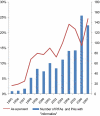Translational bioinformatics: coming of age
- PMID: 18755990
- PMCID: PMC2585538
- DOI: 10.1197/jamia.M2824
Translational bioinformatics: coming of age
Abstract
The American Medical Informatics Association (AMIA) recently augmented the scope of its activities to encompass translational bioinformatics as a third major domain of informatics. The AMIA has defined translational bioinformatics as "... the development of storage, analytic, and interpretive methods to optimize the transformation of increasingly voluminous biomedical data into proactive, predictive, preventative, and participatory health." In this perspective, I will list eight reasons why this is an excellent time to be studying translational bioinformatics, including the significant increase in funding opportunities available for informatics from the United States National Institutes of Health, and the explosion of publicly-available data sets of molecular measurements. I end with the significant challenges we face in building a community of future investigators in Translational Bioinformatics.
Figures

References
-
- Sung NS, Crowley Jr. WF, Genel M, et al. Central challenges facing the national clinical research enterpriseMar 12 JAMA 2003;289(10):1278-1287. - PubMed
-
- Payne PR, Johnson SB, Starren JB, Tilson HH, Dowdy D. Breaking the translational barriers: the value of integrating biomedical informatics and translational researchMay J Investig Med 2005;53(4):192-200. - PubMed
-
- American Medical Informatics Association AMIA Strategic Plan. 2006http://www.amia.org/inside/stratplan/ 2005. accessed Mar 15, 2007.
-
- Schena M, Shalon D, Davis RW, Brown PO. Quantitative monitoring of gene expression patterns with a complementary DNA microarray Science 1995;270(5235):467-470. - PubMed
-
- Lipshutz RJ, Morris D, Chee M, et al. Using oligonucleotide probe arrays to access genetic diversitySep Biotechniques 1995;19(3):442-447. - PubMed
Publication types
MeSH terms
Grants and funding
LinkOut - more resources
Full Text Sources

